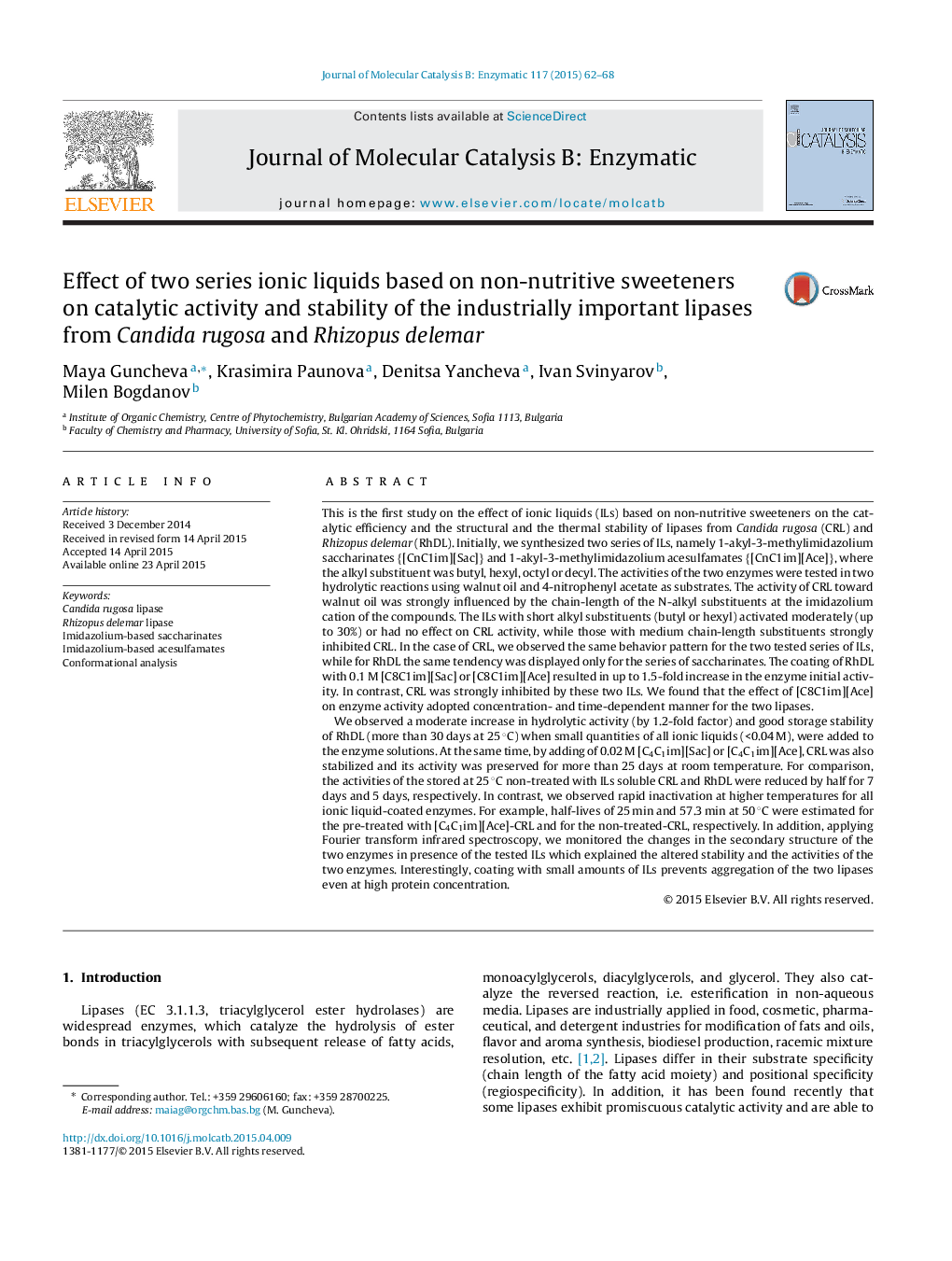| کد مقاله | کد نشریه | سال انتشار | مقاله انگلیسی | نسخه تمام متن |
|---|---|---|---|---|
| 69710 | 48788 | 2015 | 7 صفحه PDF | دانلود رایگان |

• Ionic liquids (ILs), based on saccharinate and acesulfamate anion were synthesized.
• Lipases from Rhizopus delemar and Candida rugosa were tested in these ILs.
• Activities of the two lipases strongly depended on the cation substituents.
• Coating of lipases with the tested ILs affected their thermal stability.
• Coating with small amounts of ILs improved the storage stability of the lipases.
This is the first study on the effect of ionic liquids (ILs) based on non-nutritive sweeteners on the catalytic efficiency and the structural and the thermal stability of lipases from Candida rugosa (CRL) and Rhizopus delemar (RhDL). Initially, we synthesized two series of ILs, namely 1-akyl-3-methylimidazolium saccharinates {[CnC1im][Sac]} and 1-akyl-3-methylimidazolium acesulfamates {[CnC1im][Ace]}, where the alkyl substituent was butyl, hexyl, octyl or decyl. The activities of the two enzymes were tested in two hydrolytic reactions using walnut oil and 4-nitrophenyl acetate as substrates. The activity of CRL toward walnut oil was strongly influenced by the chain-length of the N-alkyl substituents at the imidazolium cation of the compounds. The ILs with short alkyl substituents (butyl or hexyl) activated moderately (up to 30%) or had no effect on CRL activity, while those with medium chain-length substituents strongly inhibited CRL. In the case of CRL, we observed the same behavior pattern for the two tested series of ILs, while for RhDL the same tendency was displayed only for the series of saccharinates. The coating of RhDL with 0.1 M [C8C1im][Sac] or [C8C1im][Ace] resulted in up to 1.5-fold increase in the enzyme initial activity. In contrast, CRL was strongly inhibited by these two ILs. We found that the effect of [C8C1im][Ace] on enzyme activity adopted concentration- and time-dependent manner for the two lipases.We observed a moderate increase in hydrolytic activity (by 1.2-fold factor) and good storage stability of RhDL (more than 30 days at 25 °C) when small quantities of all ionic liquids (<0.04 M), were added to the enzyme solutions. At the same time, by adding of 0.02 M [C4C1im][Sac] or [C4C1im][Ace], CRL was also stabilized and its activity was preserved for more than 25 days at room temperature. For comparison, the activities of the stored at 25 °C non-treated with ILs soluble CRL and RhDL were reduced by half for 7 days and 5 days, respectively. In contrast, we observed rapid inactivation at higher temperatures for all ionic liquid-coated enzymes. For example, half-lives of 25 min and 57.3 min at 50 °C were estimated for the pre-treated with [C4C1im][Ace]-CRL and for the non-treated-CRL, respectively. In addition, applying Fourier transform infrared spectroscopy, we monitored the changes in the secondary structure of the two enzymes in presence of the tested ILs which explained the altered stability and the activities of the two enzymes. Interestingly, coating with small amounts of ILs prevents aggregation of the two lipases even at high protein concentration.
Figure optionsDownload as PowerPoint slide
Journal: Journal of Molecular Catalysis B: Enzymatic - Volume 117, July 2015, Pages 62–68